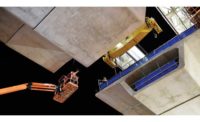
In 2008, American transportation officials were bullish on rail programs. Voters passed a majority of November ballot measures across the country to fund significant rail and transit projects, including a $9-billion measure in California for high-speed rail. Industry groups consistently called for a dedicated national freight rail program in the next federal transportation reauthorization bill.
Three years later, a sagging economy and partisan warfare in Congress has stifled the progress of rail programs in the U.S.—even as massive rail efforts have ramped up in developing countries like China and India, as well as in rich areas like the United Arab Emirates.
Governors killed an $8-billion commuter rail extension in New Jersey and a $2-billion high-speed-rail effort in Florida. The transportation reauthorization bill continues to undergo short-term extensions. Major efforts still move forward, notably some $11 billion worth of new subway and commuter rail in New York City and a planned $4-billion budget for new rail in Los Angeles.
In August, the Los Angeles Exposition Construction Authority awarded a $542-million contract for the design and construction of the 15.2-mile second phase of the so-called Expo Corridor light-rail project to a joint venture of Skanska and Rados. In Denver, a public-private partnership is building 34 miles of new commuter rail and received a $1-billion federal grant last month.
But it is in developing countries such as China and India where the most massive new starts in freight and commuter rail are taking off. Although the global economy is still an issue, governments in these countries see rail as a vital tool for economic growth.
“You’re seeing rail move from the mature markets to the more developing markets,” says George J. Pierson, chief executive officer of Parsons Brinckerhoff, New York City. “They are seeing that rail is a development tool, not a luxury.”
As a result, major U.S.-based firms looked overseas for new rail work.
Increasing Flow of Trade
One factor propelling railway construction projects is the increasing trade flows between developing nations. Economists at HSBC Holdings Plc and Royal Bank of Scotland Group Plc describe these links as the “new Silk Road.” Another geopolitical factor in the railway building taking place across Africa is China’s need for raw materials. Often China finances the projects, and in return the contractor and most of the laborers are Chinese.
Niklas Swanstrom, program director of the Central Asia-Caucasus Institute and Silk Road Studies Program at Johns Hopkins University, notes: "For the Chinese it's sort of a missing link. The further the Chinese can link their rail network to the Middle East, the less dependent they will be on ocean transport." Additional linkages to Europe will help the country spread its investments.
Tieming Liu, an officer with China Railway Group, Beijing, says that along with building 30% of the projects in China, the company is building many smaller projects in Africa and a $7.5-billion, 471-kilometer line in Venezuela. So far, about $1.5 billion of work has been completed. “The project is slowed down due to lack of cash flow from the owner,” he says. “About half of what is completed has been paid for so far. The rest of is funded by us.”
Such private investment in rail is key to many of the megaprojects around the globe.





